Liverpool Maritime Mercantile City
The Liverpool Maritime Mercantile City is a UNESCO designated World Heritage Site in Liverpool, England. It comprises six locations in the city centre of Liverpool including the Pier Head, Albert Dock and William Brown Street,[1] and includes many of the city's most famous landmarks.
| UNESCO World Heritage Site | |
|---|---|
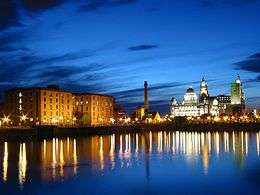 Albert Dock at night | |
| Location | Liverpool, North West England, England, United Kingdom |
| Criteria | Cultural: (ii), (iii), (iv) |
| Reference | 1150 |
| Inscription | 2004 (28th session) |
| Endangered | 2012–... |
| Area | 136 ha (340 acres) |
| Buffer zone | 750.5 ha (1,855 acres) |
| Website | www |
| Coordinates | 53°24′24″N 2°59′40″W |
 Location of Liverpool Maritime Mercantile City in North West of England 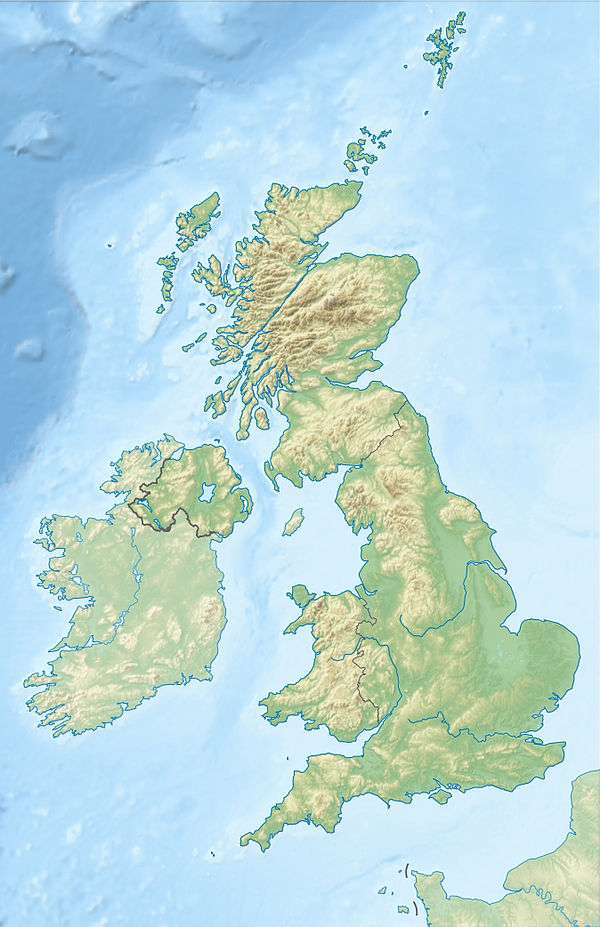 Liverpool Maritime Mercantile City (the United Kingdom) | |
UNESCO received the city council's nomination for the six sites in January 2003 and in September of that year sent ICOMOS representatives to carry out an evaluation on the eligibility for these areas to be given World Heritage Status. In March 2004 ICOMOS recommended that UNESCO inscribe the Liverpool Maritime Mercantile City as a World Heritage Site.[2]
The area was inscribed during the 28th session of the World Heritage Committee in 2004 under cultural criteria ii, iii and iv. Its inclusion by UNESCO was attributed to the fact that it was 'the supreme example of a commercial port at a time of Britain's greatest global influence'.[3]
In 2012, the site was inscribed on the List of World Heritage in Danger due to the proposed construction of Liverpool Waters project.
In July 2017, UNESCO warned that the city's status as a World Heritage Site was at risk of being rescinded in light of planning and development proposals, with English Heritage asserting that the proposed Liverpool Waters development would leave the setting of some of Liverpool's most significant historic buildings “severely compromised”, the archaeological remains of parts of the historic docks “at risk of destruction”, and “the city’s historic urban landscape ... permanently unbalanced”.[4]
Locations
The Liverpool Maritime Mercantile City comprises six separate locations throughout the centre of the city, each of which relates to a different component and time in the Liverpool's maritime history.[5] The inscribed sites extend for approximately 4 km north-south along the city's waterfront and stretch approximately 1 km east-west.[6] In total it covers an area of 136 hectares.[7]
The Pier Head
The Pier Head is the focal point of Liverpool's waterfront and is dominated by three of its most recognisable landmarks: The Liver Building, The Port of Liverpool Building and the Cunard Building. Collectively referred to as the Three Graces, they stand as a testament to the great wealth in the city during the late 19th and early 20th century when Liverpool was one of the most important ports in the world.[8] Initially plans existed to add a 'fourth grace' to area, named The Cloud and designed by Will Alsop, however this fell through in 2004. Today, in what would have been its place, a new Museum of Liverpool opened on 19 July 2011.[9][10] Behind the Port of Liverpool building is the art deco George's Dock Ventilation Tower, whose design is heavily influenced by Egyptian architectural styling.[11] Also a part of the site is the old George's Dock wall, which dates from the late 18th century, as well as several memorials, including one built to honour the engineers who remained at their post as the RMS Titanic sank.[12]
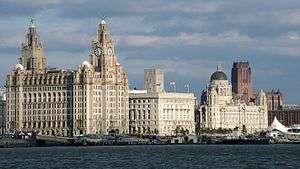
Listed Buildings[8]
|
|
The Albert Dock
The Albert Dock is a complex of dock buildings and warehouses located to the south of the Pier Head. Designed by Jesse Hartley and Philip Hardwick and opened in 1846, the Albert Dock warehouses were the first in the world to be entirely fireproof, due to their construction from only iron, brick and stone, with no structural wood.[13] The dock was home to many advances in docking technology including being the first to have hydraulic cranes.[14] During World War II the buildings suffered significant damage and general docking decline in the city after the end of the war saw them fall rapidly into disrepair. In the 1980s the area underwent massive regeneration after the creation of the Merseyside Development Corporation and the complex was reopened to the public in 1984, as part of the tall ships festival. Today they form a focal point for tourism in the city, being home to Tate Liverpool, Merseyside Maritime Museum and The Beatles Story. They also constitute the largest single collection of Grade I listed buildings anywhere in the UK.[15]
Listed Buildings[16]
|
|

The Stanley Dock Conservation Area
The Stanley Dock Conservation area is located to the north of the Pier Head and includes huge swathes of Liverpool's docking heartland. Within the site are several docks including Stanley Dock, Collingwood Dock, Salisbury Dock and Clarence Graving Dock; parts of the Leeds Liverpool Canal and associated canal locks; and many smaller features such as bridges, bollards and capstans.[17] Two of the Clarence Graving Docks are notable as the oldest docks still in use in the city today, dating back to 1830, although their full development wasn't completed until 1848.[18] Amongst the buildings in the area are the Victoria Clock Tower and Stanley Dock Tobacco Warehouse, one of the largest brick buildings in the world.[19]
Listed Buildings[17]
- Warehouse on North Side of Stanley Dock (Grade II*)
- Bonded Tea Warehouse, Great Howard Street (Grade II)
- Clarence Graving Docks (Grade II)
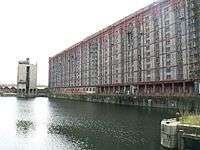
- Boundary Wall from Collingwood Dock to Huskisson Dock (Grade II)
- The Dock Master's Office, Salisbury Dock (Grade II)
- Salisbury, Collingwood and Stanley, Nelson and Bramley-Moore Dock Retaining Walls (Grade II)
- Stanley Dock Tobacco Warehouse (Grade II)
- Entrances to Stanley Dock Complex (Grade II)
- Canal Locks between Stanley Dock and Leeds and Liverpool Canal (Grade II)
- Princes Dock Boundary Wall and Piers (Grade II)
- Salisbury, Collingwood and Stanley, Nelson and Bramley-Moore Dock Retaining Walls (Grade II)
- Hydraulic Tower West of North Stanley Warehouse (Grade II)
- Victoria Tower (Grade II)
- Warehouse South of Stanley Tobacco Warehouse (Grade II)
- Waterloo Warehouse (Grade II)
Duke Street Conservation Area/ Ropewalks
The Ropewalks site comprises the south western component of the Duke Street conservation area, as well as two warehouses on College Lane and Bluecoat Chambers on School lane. The location was one of the first areas in the city to develop when Liverpool was an emerging port,[20] with Bluecoat Chambers being the oldest surviving building in Liverpool city centre, dating back to 1715.[21] Its proximity to the Old Dock, the world's first enclosed wet dock,[22] meant it was the location of the city's first property speculators who built both warehousing and residential premises along Duke St, Hannover St, and Bold St. The area soon developed a cosmopolitan feel being home to various types of people including sea captains, merchants, traders and artisans. Today the area is known as Ropewalks, a reference to the large number of roperies present in the area when Liverpool was one of the busiest ports in the world during the 18th and 19th centuries.[20]
Listed Buildings[20]
|
The 'Commercial Quarter'/Castle Street Conservation Area
This part of the WHS is focused around what would have previously been medieval Liverpool and includes Castle Street dominated by Trials Hotel at one end and the Town Hall at the other linking Old Hall Street by Exchange Flags, Victoria Street, Water Street and Dale Street. Today a centre for commercial activity in the city, the area was included due to the nature of its street development over three centuries and the grandeur of its architecture and monuments.[23]
Listed Buildings
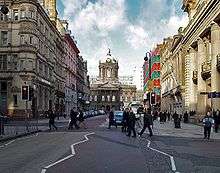 Castle Street with Liverpool Town Hall visible at the end of the road
|
The 'Cultural Quarter'/ William Brown Street Conservation Area
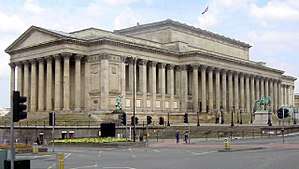
The William Brown street area is the central point for many of Liverpool's civic buildings forming a so-called 'cultural quarter'. Amongst the buildings that are focal to this part of the WHS are St George's Hall, Lime Street station, the Walker Art Gallery, the World Museum Liverpool, the former Great North Western Hotel and the entrance the Queensway Tunnel.[24]
Listed Buildings[25]
|
|
Inscription
Having received the nomination for the area in January 2003, the International Council on Monuments and Sites (ICOMOS) travelled to Liverpool in September of that year to carry out an evaluation on behalf of UNESCO. The ICOMOS evaluation analysed the city in relation to its nomination document, looking at four key areas: conservation, authenticity and integrity, comparative evaluation and outstanding universal value.[2]
- Conservation - In terms of conservation status ICOMOS were happy that a wide range of buildings from the 18th through to 20th century were preserved within the city, despite two world wars and significant decline during the 1970s. However, they keenly stressed the importance of continued preservation suggesting that all future developments within the nominated areas are stringently monitored.
- Authenticity and integrity - ICOMOS were pleased with manner in which the nominated areas had maintained the majority of their historical integrity, despite some major regeneration and development projects since the Second World War. The urban fabric of the six sites ranged from the 18th to 20th century and the committee were happy that the city's street pattern provided a readable representation of different periods in Liverpool's history.
- Comparative evaluation - As part of their evaluation ICOMOS compared Liverpool's maritime history with that of other major ports throughout both the UK and wider world. They felt that Liverpool had values and qualities that set it apart from many other port cities both in terms of its maritime function and architectural and cultural significance.
- Outstanding universal value - In analysing Liverpool's Maritime Mercantile City in terms of its universal value, ICOMOS concurred with the local council that Liverpool was the 'supreme example of a commercial port at the time of Britain's greatest global influence'. In particular they noted the role the city played in the trans-Atlantic slave trade, the development of docking technology and railway transportation, and the attention given to cultural activities and architecture.
Upon completion of their evaluation, ICOMOS returned to UNESCO with the recommendation that the area be inscribed as a world heritage site. At the same time they made several recommendations regarding future preservation and development within the areas and their buffer zones.[2] As a result, the Liverpool Maritime Mercantile City was inscribed as a world heritage site at the 28th session of the World Heritage Committee in 2004, under the cultural criteria ii, iii and iv:[26]
- Criterion (ii): "Liverpool was a major centre generating innovative technologies and methods in dock construction and port management in the 18th and 19th centuries. It thus contributed to the building up of the international mercantile systems throughout the British Commonwealth."
- Criterion (iii): "The city and the port of Liverpool are an exceptional testimony to the development of maritime mercantile culture in the 18th and 19th centuries, contributing to the building up of the British Empire. It was a centre for the slave trade, until its abolition in 1807, and for emigration from northern Europe to America."
- Criterion (iv): "Liverpool is an outstanding example of a world mercantile port city, which represents the early development of global trading and cultural connections throughout the British Empire."
See also
- World Heritage Sites in Danger
References
Notes
- "Liverpool – Maritime Mercantile City". UK Local Authority World Heritage Forum. Archived from the original on 23 April 2008. Retrieved 9 October 2008.
- "Liverpool (United Kingdom) - NO 1050" (PDF). ICOMOS. 2004. Retrieved 9 December 2008.
- "Welcome to Liverpool World Heritage". Liverpool City Council. Archived from the original on 22 February 2008. Retrieved 9 October 2008.
- Perraudin, Frances (3 October 2017). "Liverpool faces up to world heritage removal threat with taskforce". the Guardian.
- "Liverpool - Maritime Mercantile City". Visit Britain. Retrieved 9 October 2008.
- Liverpool City Council (2005), p17
- Liverpool City Council (2005), p26
- "Pier Head". World Heritage Liverpool. Archived from the original on 7 February 2009. Retrieved 10 December 2008.
- "Museum of Liverpool". Liverpool museums. Retrieved 6 February 2012.
- "Building a New Museum". National Museums Liverpool. Retrieved 30 October 2008.
- "George's Dock Ventilation". Liverpool World Heritage. Retrieved 10 December 2008.
- "Memorial to the Engine Room Heroes of the Titanic". Liverpool World Heritage. Retrieved 10 December 2008.
- Jones, Ron (2004). The Albert Dock, Liverpool. RJ Associates Ltd. p. 83.
- Jones, Ron (2004). The Albert Dock, Liverpool. RJ Associates Ltd. p. 46.
- Helen Carter (7 March 2003). "Glory of Greece, grandeur of Rome ... and docks of Liverpool". Guardian Unlimited. Retrieved 27 March 2007.
- "The Albert Dock Conservation Area". Liverpool World Heritage. Retrieved 11 March 2009.
- "The Stanley Dock Conservation area". Liverpool World Heritage. Archived from the original on 6 May 2008. Retrieved 7 March 2009.
- "Clarence Graving Docks". Liverpool World Heritage. Retrieved 9 March 2009.
- "The Stanley Dock Tobacco Warehouse". Liverpool World Heritage. Archived from the original on 4 December 2008. Retrieved 7 November 2008.
- "Duke Street Area/Ropewalks". Liverpool World Heritage. Archived from the original on 26 June 2009. Retrieved 1 November 2008.
- Pollard, Richard; Nikolaus Pevsner (2006). The Buildings of England: Lancashire: Liverpool and the South-West. New Haven & London: Yale University Press. pp. 302–304.
- "Trading Places: Old Dock History". National Museums Liverpool. Archived from the original on 24 March 2008. Retrieved 1 November 2008.
- "Castle/Dale/Old Hall St Commercial Centre". Liverpool World Heritage. Archived from the original on 19 July 2008. Retrieved 6 November 2008.
- "William Brown St Conservation Area". Liverpool World Heritage. Archived from the original on 26 July 2011. Retrieved 7 November 2008.
- "William Brown St Conservation Area". Liverpool World Heritage. Archived from the original on 26 July 2011. Retrieved 14 September 2009.
- "Nominations of Cultural Properties to the World Heritage List (Liverpool - Maritime Mercantile City)". UNESCO. Retrieved 23 October 2008.
Bibliography
- Liverpool City Council (2005). Maritime Mercantile City: Liverpool. Liverpool University Press. ISBN 1-84631-006-7.
- Oevermann, H.; Mieg, H.A., eds. (2014). Industrial Heritage Sites in Transformation: Clash of Discourses. Routledge. ISBN 978-0415745284.
External links
| Wikimedia Commons has media related to Liverpool Docks. |

